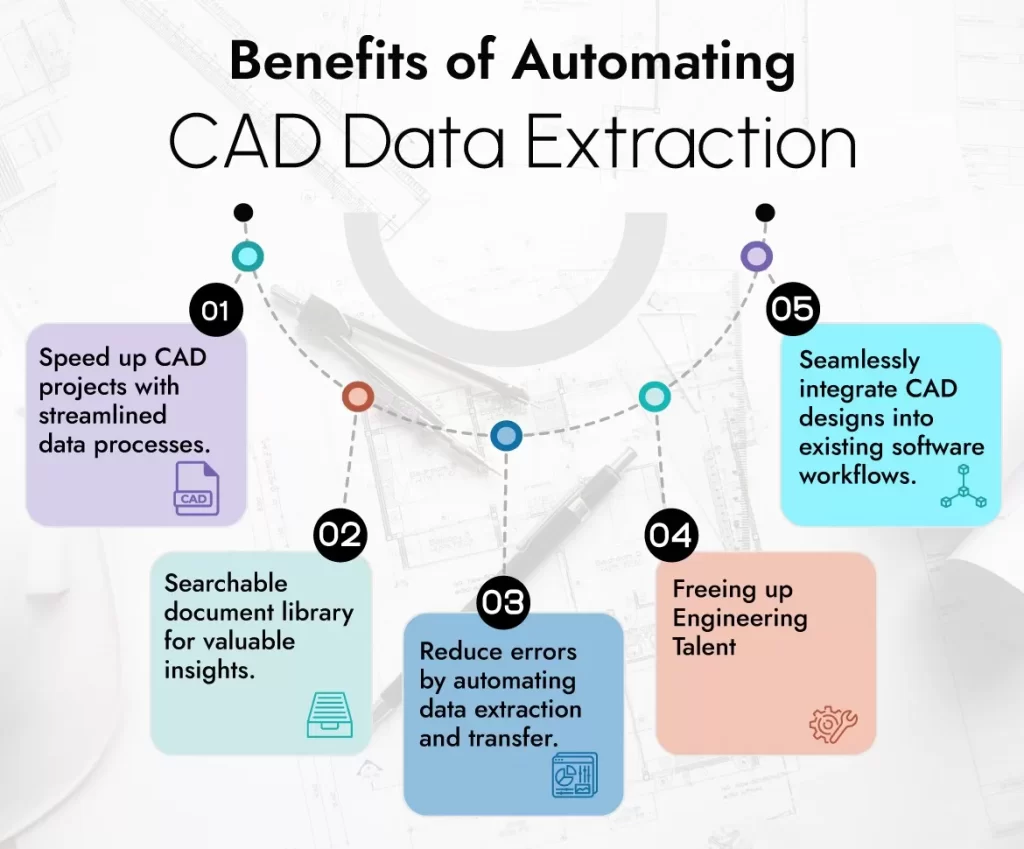In today’s fast-paced business environment, manual data extraction and analysis are increasingly being replaced by powerful automation applications. As digital transformation accelerates, more industries are adopting automation technologies to optimize operations, maximize resource utilization, and enhance efficiency. Automating CAD document processing is especially transformative, promising to reshape multiple sectors.
Understanding Automated CAD Data Extraction
Phases of Automated CAD Data Extraction
1. File Parsing: The process begins by parsing the CAD file in formats such as DWG, DXF, or STEP, enabling the system to read the file’s structure and identify entities, layers, and objects in the design.
2. Object Detection Algorithms: The system uses object detection algorithms to recognize and categorize elements like lines, curves, text, dimensions, symbols, and other geometric and textual components within the CAD design.
3. Attribute Extraction: After object identification, specific attributes like dimensions, materials, annotations, and geometric details (coordinates, angles, distances) are extracted.
4. Data Validation: Extracted data is validated for accuracy and consistency, comparing values against predefined rules and standards to ensure they fit the CAD design context.
5. Data Structuring: Organized and structured into a usable format, the extracted data is made ready for further analysis or integration with other software systems, often converted into standardized formats or database entries.
6. Text Recognition: For textual data like labels or annotations, OCR technology converts images of text into machine-readable text, enabling easy extraction and analysis.
7. Automation Rules: Configurable rules and templates tailored to industry or organizational needs govern data extraction, validation, and structuring to ensure reliable results.
8. Machine Learning and AI: Advanced CAD data extraction systems use machine learning and AI algorithms to improve accuracy over time, adapting to different CAD designs and formats by recognizing patterns and optimizing extraction.
9. User Interface: User-friendly interfaces allow customization of extraction parameters, specifying what data to retrieve, and reviewing extracted information. Interfaces often include drag-and-drop or scripting options for easy configuration.
10. Integration: Extracted data can be integrated with PLM, ERP, or data analytics tools, enabling smooth data sharing and utilization across various organizational systems.

Unlocking the Potential of Automated CAD Data Extraction Across Industries
1. Manufacturing and Engineering Optimization: CAD extraction tools automatically retrieve data like dimensions, materials, and tolerances, minimizing errors and ensuring precision, resulting in cost savings and improved product quality. Quality-related costs can reach up to 20% of total revenue, posing challenges for both OEMs and smaller manufacturers. Automating Bill of Materials (BOM) creation reduces manual entry errors, with CAD-driven BOM automation yielding a 50% reduction in change order cycle times, according to the Aberdeen Group.
2. Speeding Up Architecture and Construction: CAD data extraction accelerates cost estimation and bidding by automating material quantification, resulting in shorter project timelines and increased profitability. Automation also enhances collaboration and change management, reducing design-related errors, which can account for up to 5% of project costs, per the Construction Industry Institute (CII).
3. Automotive and Aerospace Precision: In the automotive and aerospace industries, CAD data extraction enables component analysis, helping optimize designs for weight, strength, and efficiency—critical for fuel economy and safety. A Frost & Sullivan study indicates that CAD automation has reduced time-to-market by 15% for automakers.
4. Enhancing PCB Design for Electronics: In electronics, CAD extraction simplifies issue identification in PCB designs, expediting development cycles. Automating component data extraction streamlines sourcing, with Accenture reporting that supply chain disruptions can cost companies up to 34% of their operating income.
5. Customization in Consumer Goods and Retail: CAD extraction supports product customization by adapting designs to meet customer preferences, boosting brand loyalty and revenue. Speeding up prototyping through CAD data extraction accelerates time-to-market, with companies using CAD-driven 3D printing achieving an average 57%-time savings in prototype development, per Wohlers Associates.
6. Innovation in Healthcare and Medical Devices: In healthcare, CAD extraction aids in the precise design and regulatory compliance of medical devices, accelerating approval and launch processes. This technology also enables the creation of custom implants and prosthetics, leading to highly personalized patient solutions
7. Efficiency in Oil, Gas, Energy, and Utilities: According to the World Economic Forum, digital technologies in the oil and gas industry, including CAD automation, can reduce operational costs by up to 20%. CAD data extraction helps design and maintain complex infrastructure, reducing downtime and boosting efficiency. Preventive maintenance, supported by CAD data, can cut downtime by up to 18%, as reported by Plant Engineering.
Reverse Indexing: Tracing Design Origins
Final Thoughts
As you begin to automate CAD data extraction, start with clear goals. Identify specific challenges, desired outcomes, and metrics for success by setting SMART (Specific, Measurable, Achievable, Relevant, Time-bound) objectives to guide the planning, execution, and assessment of your initiatives.
Connect with our AI and Machine Learning experts to explore tailored, business-focused solutions for CAD data extraction.
Enhancing your workflow through AI integration is key to future success.
I design and refine AI solutions that make workflows smarter and turn data into actionable insights. With expertise in OCR, deep learning, and computer vision, I focus on translating complex concepts into reliable, scalable systems that solve real-world problems and create measurable value.





